Financial Risk Management for Sustainable Agricultural Development Based on Corporate Social Responsibility in the Interests of Food Security
Abstract
:1. Introduction
2. Literature Review
3. Methodology
- The dependence of food security indicators (according to the materials of The Economist Intelligence Unit Limited (2021)) on the financial risks in agriculture (according to the materials of The Economist Intelligence Unit Limited (2021));
- The dependence of the selected key financial risks in agriculture on the World Giving Index (according to the materials of the Charities Aid Foundation (2021)).
- Change in average food costs (fc);
- Agricultural import tariffs (it);
- Funding for food safety net programmes (fs);
- Access to finance and financial products for farmers (fp);
- Access to diversified financial products for farmers (df);
- Access to market data and mobile banking (mb).
- Affordability (FS1);
- Availability (FS2);
- Quality and safety (FS3);
- Natural resources and resilience (FS4).
4. Results
4.1. Modeling of the Financial Risk Management for Sustainable Agricultural Development Based on Corporate Social Responsibility in the Interests of Food Security
- FS1 = 45.003 + 0.23 × fs + 0.18 × df. According to the obtained regression equation, with an increase in funding for food safety net programs by 1%, affordability increases by 0.23 points. With a 1% increase in access to diversified financial products, affordability increases by 0.18 points. Fobs = 124.57. For 86 observations and 2 variables at a significance level of 0.05 Ftabl = 4.00. Since Fobs > Ftabl (124.57 > 4.00), the F-test is passed. Consequently, the obtained equation is reliable at a significance level of 0.05. The coefficient of multivariable correlation R2 = 0.8661. Variance Inflation Factor (VIF): VIF = 1/(1 − R2) = 1/(1 − 0.8661) = 7.47. Since VIF does not exceed 10, multicollinearity is low, and spurious regression is absent.
- FS2 = 50.29 + 0.13 × df. According to the obtained regression equation, with an increase in access to diversified financial products by 1%, availability increases by 0.13 points. Fobs = 25.22. For 86 observations and 1 variable at a significance level of 0.05 Ftabl = 3.15. Since Fobs > Ftabl (25.22 > 3.15), the F-test is passed. Therefore, the obtained equation is reliable at a significance level of 0.05. The coefficient of multivariable correlation R2 = 0.4805. Variance Inflation Factor (VIF): VIF = 1/(1 − R2) = 1/(1 − 0.4805) = 1.92. Since VIF does not exceed 10, multicollinearity is low, and spurious regression is absent.
- FS3 = 45.17 + 0.18 × it + 0.22 × fs. According to the obtained regression equation, with an increase in agricultural import tariffs by 1%, quality and safety increases by 0.18 points. With an increase in funding for food safety net programs by 1%, quality and safety increases by 0.22 points. Fobs = 44.65. For 86 observations and 2 variables at a significance level of 0.05 Ftabl = 4.00. Since Fobs > Ftabl (44.65 > 4.00), the F-test is passed. Therefore, the obtained equation is reliable at a significance level of 0.05. The coefficient of multivariable correlation R2 = 0.7199. Variance Inflation Factor (VIF): VIF = 1/(1 − R2) = 1/(1 − 0.7199) = 3.57. Since VIF does not exceed 10, multicollinearity is low, and spurious regression is absent.
- FS4 = 42.56 + 0.15 × df. According to the obtained regression equation, with an increase in access to diversified financial products by 1%, natural resources and agricultural sustainability increase by 0.15 points. Fobs = 44.46. For 86 observations and 1 variable at a significance level of 0.05 Ftabl = 3.15. Since Fobs < Ftabl (44.46 > 3.15), the F-test is passed. Therefore, the obtained equation is reliable at a significance level of 0.05. The coefficient of multivariable correlation R2 = 0.5883. Variance Inflation Factor (VIF): VIF = 1/(1 − R2) = 1/(1 − 0.5883) = 2.43. Since VIF does not exceed 10, multicollinearity is low, and spurious regression is absent.
4.2. Seed Production Development Trends in Russia in the Context of Food Security
- Rostov Region—winter wheat, sunflower for grain, spring barley, and grain maize;
- Krasnodar Territory—winter wheat, grain maize, peas, sugar beet, sunflower for grain, and soybeans;
- Altay Territory—spring wheat, oats, buckwheat and rapeseed, sunflower for grain, soybeans, and peas;
- Saratov Region—sunflower for grain, winter wheat, and buckwheat;
- Voronezh Region—spring barley, sugar beet, winter wheat, sunflower for grain, grain maize, soybeans, and potatoes;
- The Republic of Tatarstan—spring barley, potatoes, oats, rapeseed, peas, buckwheat, and sugar beet;
- Kursk Region—grain maize, soybeans, sugar beet, winter wheat, spring barley, and buckwheat;
- Krasnoyarsk Territory—oats, rapeseed, spring wheat, and potatoes;
- Belgorod Region—soybeans, winter wheat, grain maize, and sugar beet;
- Amur Region—soybeans;
- Stavropol Territory—peas, winter wheat, and rapeseed;
- Bryansk Region—potatoes and grain maize;
- Orel Region—buckwheat, winter wheat, spring barley, grain maize, soybeans, and sugar beet;
- The Republic of Bashkortostan—buckwheat, spring wheat, spring barley, oats, peas, potatoes, and sugar beet;
- Lipetsk Region—sugar beet, sunflower for grain, spring barley, soybeans, and rapeseed.
- Transition from regular seeds to elite seeds;
- Increase in the use of production capacities;
- Voluntary certification of quality.
5. Discussion
6. Conclusions
Author Contributions
Funding
Conflicts of Interest
Appendix A
| N | Country | N | Country |
|---|---|---|---|
| 1 | Algeria | 2 | Mali |
| 3 | Argentina | 4 | Mexico |
| 5 | Australia | 6 | Morocco |
| 7 | Austria | 8 | Myanmar |
| 9 | Bahrain | 10 | Nepal |
| 11 | Bangladesh | 12 | Netherlands |
| 13 | Belgium | 14 | New Zealand |
| 15 | Benin | 16 | Nicaragua |
| 17 | Bolivia | 18 | Nigeria |
| 19 | Brazil | 20 | Norway |
| 21 | Bulgaria | 22 | Pakistan |
| 23 | Cambodia | 24 | Paraguay |
| 25 | Cameroon | 26 | Peru |
| 27 | Canada | 28 | Philippines |
| 29 | Chile | 30 | Poland |
| 31 | China | 32 | Portugal |
| 33 | Colombia | 34 | Romania |
| 35 | Congo (Dem. Rep.) | 36 | Russia |
| 37 | Costa Rica | 38 | Saudi Arabia |
| 39 | Côte d’Ivoire | 40 | Senegal |
| 41 | Czech Republic | 42 | Serbia |
| 43 | Denmark | 44 | Slovakia |
| 45 | Dominican Republic | 46 | South Africa |
| 47 | Ecuador | 48 | Spain |
| 49 | Egypt | 50 | Sri Lanka |
| 51 | El Salvador | 52 | Sweden |
| 53 | Ethiopia | 54 | Switzerland |
| 55 | Finland | 56 | Tajikistan |
| 57 | France | 58 | Tanzania |
| 59 | Germany | 60 | Thailand |
| 61 | Ghana | 62 | Tunisia |
| 63 | Greece | 64 | Turkey |
| 65 | Hungary | 66 | Uganda |
| 67 | India | 68 | Ukraine |
| 69 | Indonesia | 70 | United Arab Emirates |
| 71 | Ireland | 72 | United Kingdom |
| 73 | Israel | 74 | United States |
| 75 | Italy | 76 | Uruguay |
| 77 | Japan | 78 | Uzbekistan |
| 79 | Jordan | 80 | Venezuela |
| 81 | Kazakhstan | 82 | Vietnam |
| 83 | Kenya | 84 | Yemen |
| 85 | Malaysia | 86 | Zambia |
References
- Belhadi, Amine, Sachin Kamble, Venkatesh Mani, Imane Benkhati, and Fatima Ezahra Touriki. 2021. An ensemble machine learning approach for forecasting credit risk of agricultural SMEs’ investments in agriculture 4.0 through supply chain finance. Annals of Operations Research, 1–29. [Google Scholar] [CrossRef] [PubMed]
- Charities Aid Foundation. 2021. CAF World Giving Index 2021. Available online: https://www.cafonline.org/about-us/publications/2021-publications/caf-world-giving-index-2021 (accessed on 7 August 2021).
- De Olde, Evelin M., and Vladislav Valentinov. 2019. The Moral Complexity of Agriculture: A Challenge for Corporate Social Responsibility. Journal of Agricultural and Environmental Ethics 32: 413–30. [Google Scholar] [CrossRef] [Green Version]
- Diamantopoulos, Adamantios, and Heldi M. Winklhofer. 2001. Index Construction With Formative Indicators: An Alternative to Scale Development. Journal of Marketing Research 38: 269–77. [Google Scholar] [CrossRef]
- Frascarelli, Angelo, Simone Del Sarto, and Giada Mastandrea. 2021. A New Tool for Covering Risk in Agriculture: The Revenue Insurance Policy. Risks 9: 131. [Google Scholar] [CrossRef]
- Grabs, Janina, and Sophia Louise Carodenuto. 2021. Traders as sustainability governance actors in global food supply chains: A research agenda. Business Strategy and the Environment 30: 1314–32. [Google Scholar] [CrossRef]
- Graddy-Lovelace, Garrett. 2021. Farmer and non-farmer responsibility to each other: Negotiating the social contracts and public good of agriculture. Journal of Rural Studies 82: 531–41. [Google Scholar] [CrossRef]
- Hair, Joseph, Jr., William Black, Barry Babin, and Rolph Anderson. 2010. Multivariate Data Analysis: A Global Perspective, 7th ed. New York: Pearson. [Google Scholar]
- Hajdu, Anna, Taras Gagalyuk, Eduard Bukin, and Martin Petrick. 2021. Determinants of Corporate Social Responsibility Among Farms in Russia and Kazakhstan: A Multilevel Approach Using Survey Data. International Food and Agribusiness Management Review 24: 697–716. [Google Scholar] [CrossRef]
- Kang, Yunhee, Anurima Baidya, Alec Aaron, Jun Wang, Christabel Chan, and Erica Wetzle. 2021. Differences in the early impact of COVID-19 on food security and livelihoods in rural and urban areas in the Asia Pacific Region. Global Food Security 31: 100580. [Google Scholar] [CrossRef]
- Korolkova, Anna, Vitaliy Kuzmin, Tatiana Marinchenko, and Anna Goryacheva. 2020. Stimulating the Development of Breeding and Seed Production of Crops: Domestic and Foreign Experience: An Analytical Review. Moscow: Federal State Budgetary Scientific Institution “Rosinformagrotech”. [Google Scholar]
- Laskov, Valeriy. 2008. Self-regulation and regulation of agricultural planning in the region. Economist 5: 40–45. [Google Scholar]
- MCX. 2021. Changes in Approaches to the Distribution of the “Single Subsidy” Are Being Prepared. Available online: http://mcx.ru/press-service/news/gotovyatsya-izmeneniya-podkhodov-k-raspredeleniyu-edinoy-subsidii/ (accessed on 7 August 2021).
- Mojtahedi, Fatameh, Seyed Mojtaba Mojaverian, Daniel Ahelegbey, and Paolo Giudici. 2020. Tail Risk Transmission: A Study of the Iran Food Industry. Risks 8: 78. [Google Scholar] [CrossRef]
- Molitor, Fred, Celeste Doerr, and Sarah Kehl. 2021. Unemployment, SNAP Enrollment, and Food Insecurity Before and After California’s COVID-19 Shutdown. Journal of Nutrition Education and Behavior 53: 1055–59. [Google Scholar] [CrossRef] [PubMed]
- Mukhopadhyay, Raj, Binoy Sarkar, Hanuman Sahay Jat, Parbodh Chander Sharma, and Nanthi Bolan. 2021. Soil salinity under climate change: Challenges for sustainable agriculture and food security. Journal of Environmental Management 280: 111736. [Google Scholar] [CrossRef]
- Oubraham, Farid, Slimane Bédrani, and Fathi Abdellatif Belhouadjeb. 2021. Does interest rate subsidy really promote the financing of farms? The case of the wilaya of Laghouat in Algeria. Cahiers Agricultures 30. [Google Scholar] [CrossRef]
- Pawlak, Karolina, and Malgorzata Kołodziejczak. 2020. The role of agriculture in ensuring Food security in developing countries: Considerations in the context of the problem of sustainable food production. Sustainability 12: 5488. [Google Scholar] [CrossRef]
- Polukhin, Andrey, and Veronica Panarina. 2017. Seed production as the basis of Food security in the Russian Federation. Agricultural Economics of Russia 4: 55–59. [Google Scholar]
- Popkova, Elena Gennadievna, and Bruno Sergio Sergi. 2021. Paths to the Development of Social Entrepreneurship in Russia and Central Asian Countries: Standardization Versus De-Regulation. Entrepreneurship for Social Change. Bingley: Emerald Publishing Limited, pp. 161–77. [Google Scholar] [CrossRef]
- Popkova, Elena Gennadievna, Paper DeLo, and Bruno Sergio Sergi. 2020. Corporate Social Responsibility amid Social Distancing During the COVID-19 Crisis: BRICS vs. OECD Countries. Research in International Business and Finance 55: 101315. [Google Scholar] [CrossRef] [PubMed]
- Qian, Xiaoyan, and Tava Lennon Olsen. 2021. Financial and risk management in agricultural cooperatives with application to the milk industry in New Zealand. International Journal of Production Research 59: 5913–43. [Google Scholar] [CrossRef]
- Rosselkhoztsentr. 2021a. Rosselkhoztsentr Information Sheet No. 23. 2017. Available online: https://rosselhoscenter.com/index.php/pressa/analitika/10615-informatsionnyj-listok-rosselkhoztsentra-23-2017-zaklyuchitelnaya-spravka-o-kachestve-vyseyannykh-semyan-ynovyarovykh-zernobo-kultur-v-khozyajstvakh-rossijskoj-federatsii-v-2017-godu (accessed on 7 August 2021).
- Rosselkhoztsentr. 2021b. Rosselkhoztsentr information Sheet No. 24. 2018. Available online: https://rosselhoscenter.com/index.php/pressa/analitika (accessed on 7 August 2021).
- Rosselkhoztsentr. 2021c. Register of seed farms of the Russian Federation FGBU “Rosselkhoztsentr”. Available online: https://rosselhoscenter.com/index.php/2014-02-28-11-39-42/reestr-semenovodcheskikh-khozyajstv (accessed on 7 August 2021).
- Rosselkhoztsentr. 2021d. Rosselkhoztsentr Information Sheet No. 21. 2020. Available online: https://rosselhoscenter.com/ (accessed on 7 August 2021).
- Rosstat. 2021a. Acreage of the Russian Federation in 2016–2020. Available online: https://rosstat.gov.ru/compendium/document/13277 (accessed on 7 August 2021).
- Rosstat. 2021b. Gross Yield and Productivity of Crops in the Russian Federation in 2020. Available online: https://fedstat.ru/indicator/30950 (accessed on 7 August 2021).
- Svitacova, Eva Pechociakova. 2021. Environmental responsibility in sustainable agriculture. Bulgarian Journal of Agricultural Science 27: 880–86. [Google Scholar]
- Szczepankiewicz, Elżbieta Izabela. 2021. Identification of Going-Concern Risks in CSR and Integrated Reports of Polish Companies from the Construction and Property Development Sector. Risks 9: 85. [Google Scholar] [CrossRef]
- Tang, Hondley, Zeeshan Rasool, Ahmad Imran Khan, Anum Afazl Khan, Moshin Ali Khan, and Ghalum Ahmad Azaz. 2021. The Impact of Private Standards on Corporate Social Responsibility Compliance and Rural Workers’ Motivation in Developing Countries: A Study of Mango Farms in Pakistan. International Journal of Food Science. [Google Scholar] [CrossRef] [PubMed]
- Ter-Grigoryants, Anna Aleksandrovna. 2010. The main directions of the strategy for the development of agriculture in the region. Bulletin of the North Caucasus State Technical University 2: 171–76. [Google Scholar]
- The Economist Intelligence Unit Limited. 2021. The Global Food Security Report 2021. Available online: https://foodsecurityindex.eiu.com/Country (accessed on 7 August 2021).
- Tong, Zeping, and Shuo Yang. 2021. The Research of Agricultural SMEs Credit Risk Assessment Based on the Supply Chain Finance. E3S Web of Conferences 275: 01061. [Google Scholar] [CrossRef]
- Vavrek, Roman, Ivana Kravčáková Vozárová, and Rastislav Kotulič. 2021. Evaluating the financial health of agricultural enterprises in the conditions of the slovak republic using bankruptcy models. Agriculture 11: 242. [Google Scholar] [CrossRef]
- Volkenand, Steffen, Günther Filler, and Martin Odening. 2021. Price Discovery and Market Reflexivity in Agricultural Futures Contracts with Different Maturities. Risks 8: 75. [Google Scholar] [CrossRef]
- Wang, Zhengjun, Junling Mu, and Yuehong Zheng. 2020. Construction of Farmer’s Financing Mode under Internet Finance Embedded. Paper presented at 2020 International Conference on Big Data Economy and Information Management, BDEIM 2020, Zhenzhou, China, December 11–13; pp. 25–28. [Google Scholar] [CrossRef]
- Budiasa, Wayan. 2020. Green financing for supporting sustainable agriculture in Indonesia. In IOP Conference Series: Earth and Environmental Science. Bristol: IOP Publishing, vol. 518, p. 012042. [Google Scholar] [CrossRef]
- Zhang, Dehua. 2020. The Innovation Research of Contract Farming Financing Mode under the Block Chain Technology. Journal of Cleaner Production 270: 122194. [Google Scholar] [CrossRef]
- Zhu, Bo, Renda Lin, Yuanyue Deng, Pingshe Chen, and Julien Chevallier. 2021. Intersectoral systemic risk spillovers between energy and agriculture under the financial and COVID-19 crises. Economic Modelling 105: 105651. [Google Scholar] [CrossRef]
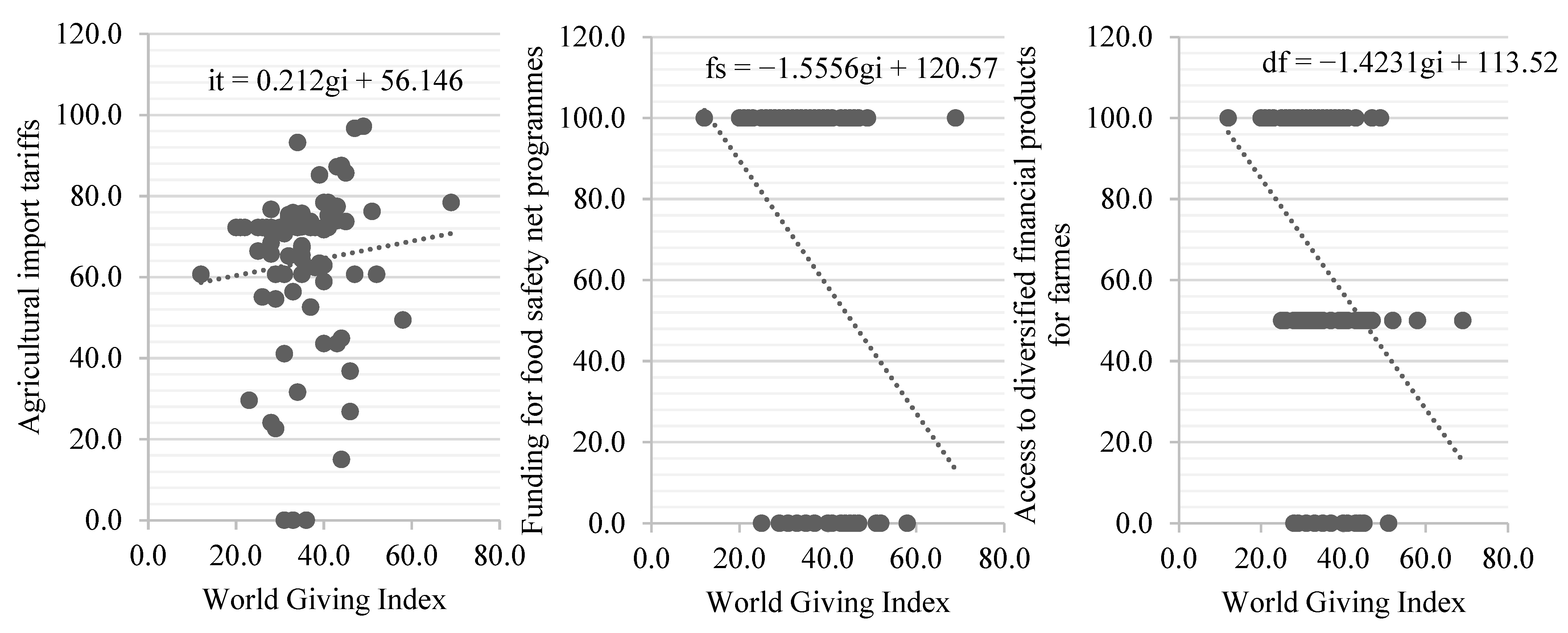
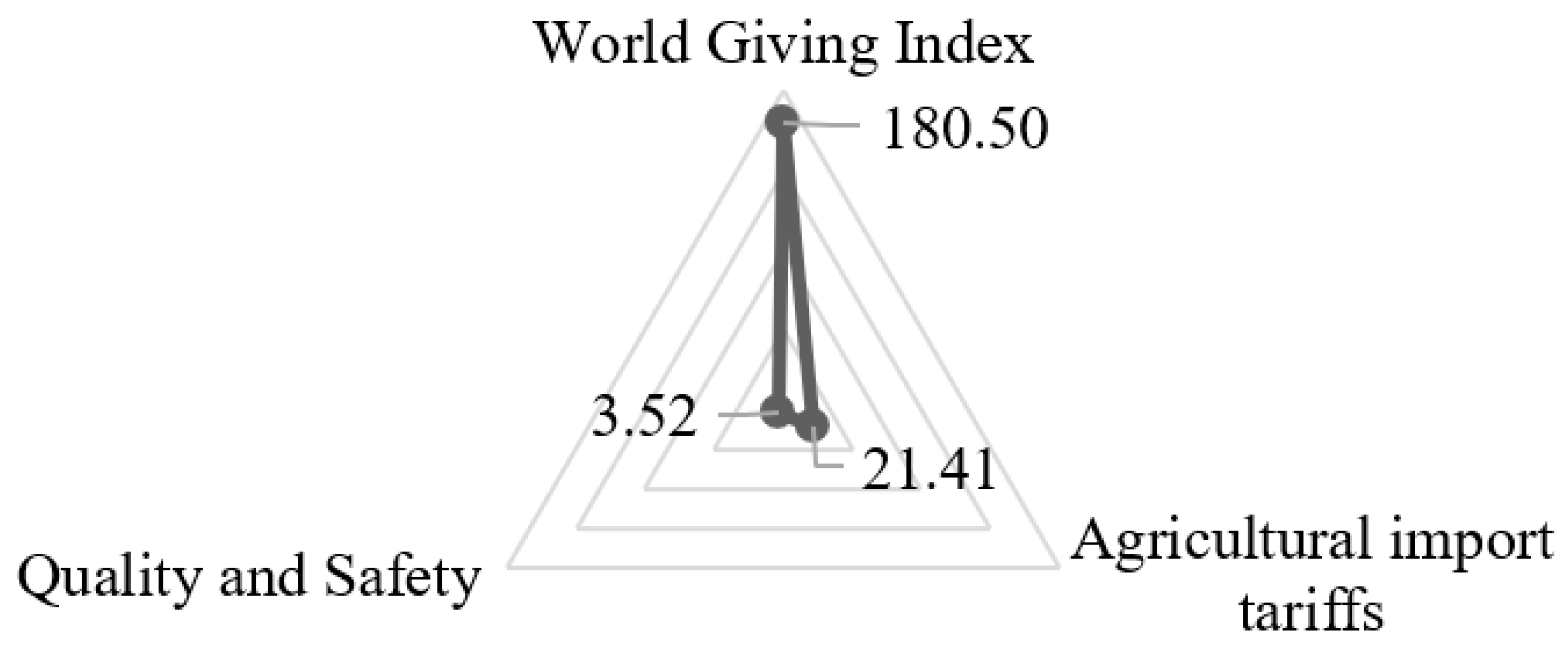
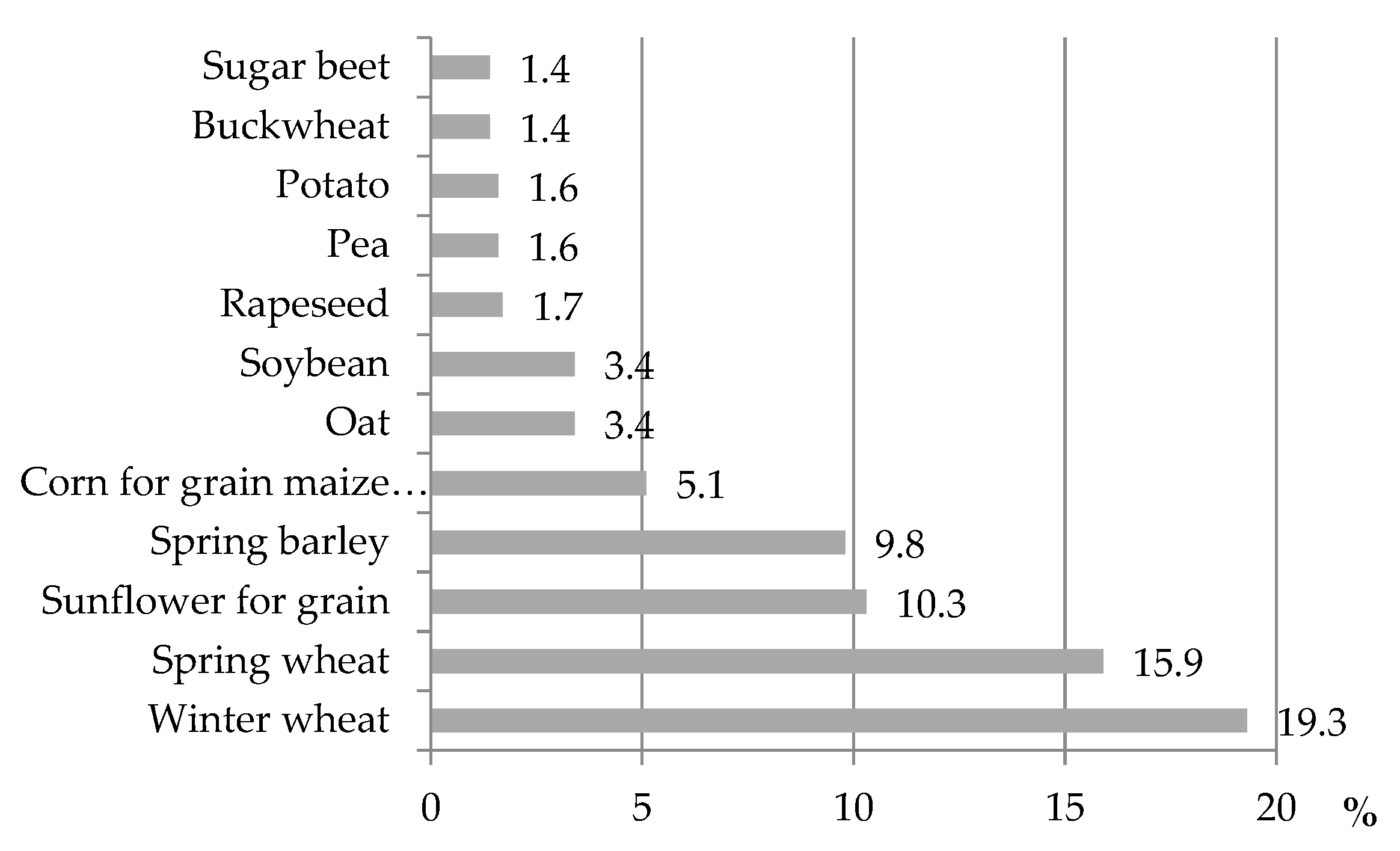
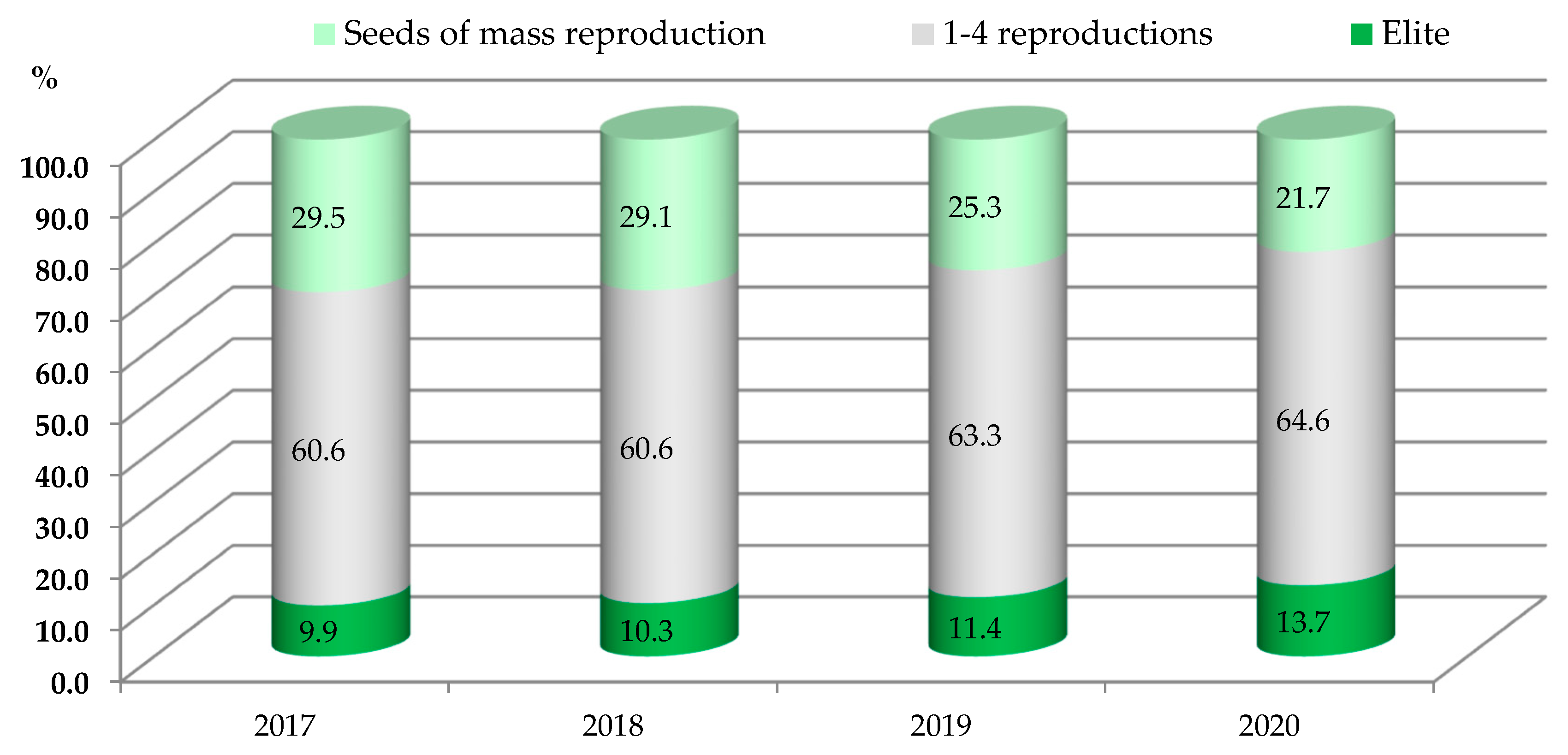
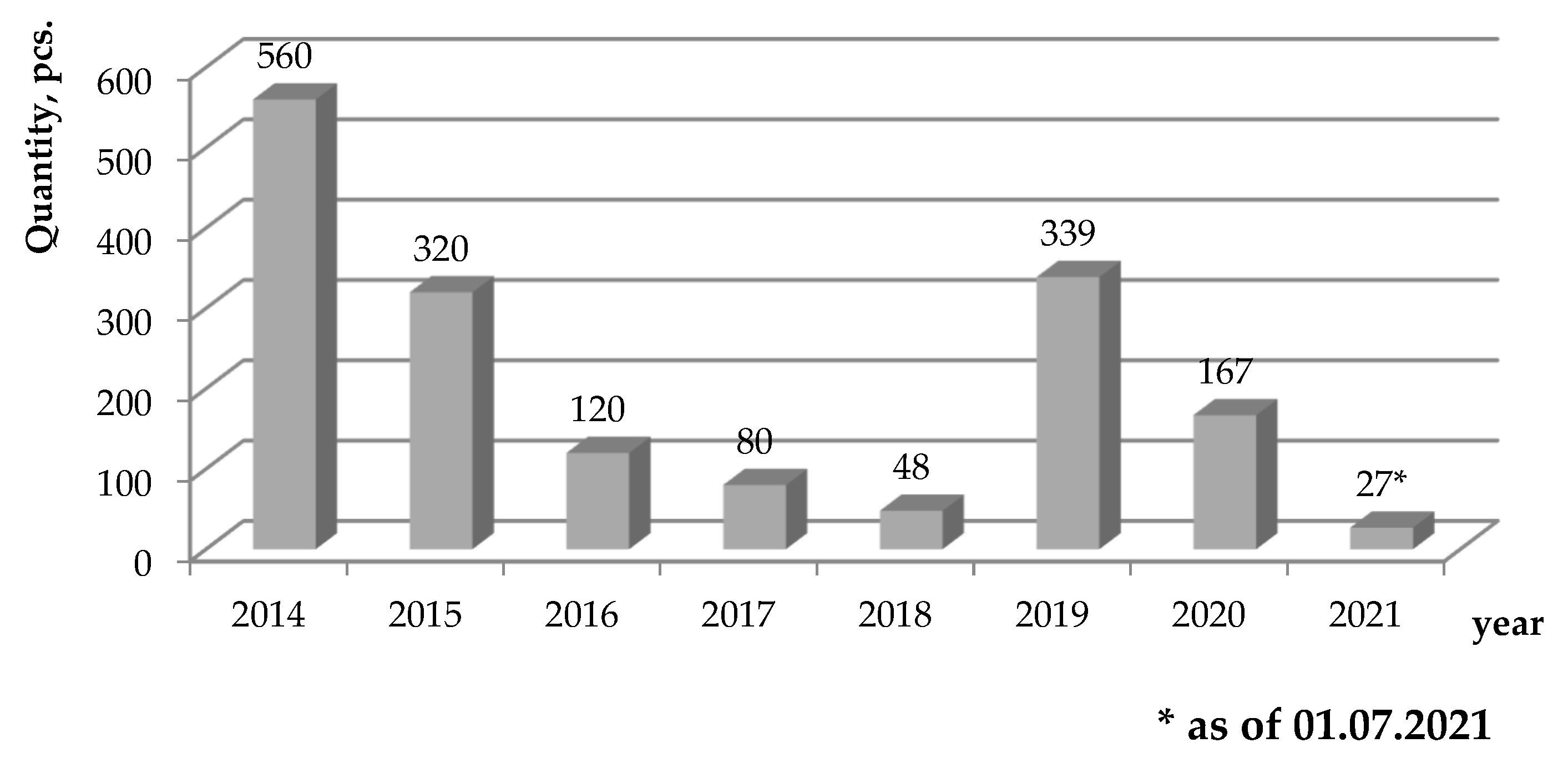
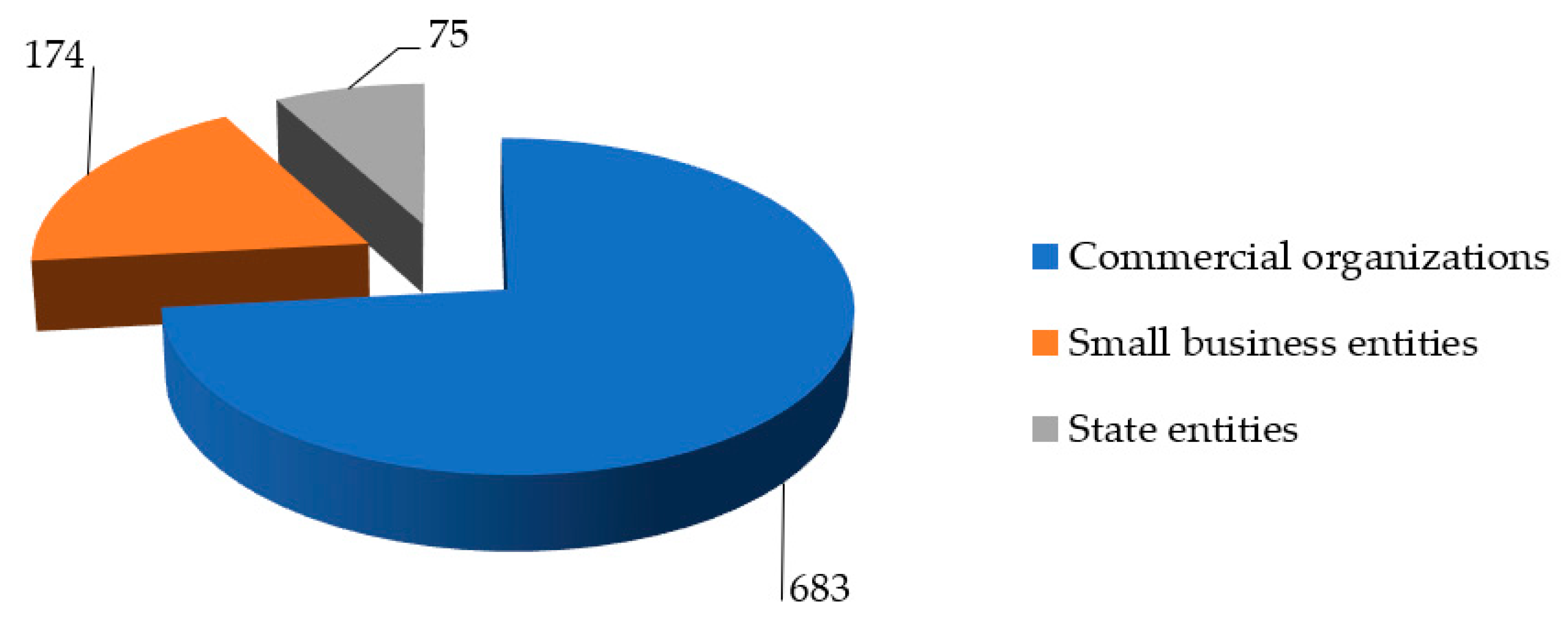
| Region | Share in the Total Structure of Acreage, % | Acreage, Thousand Ha. |
|---|---|---|
| Rostov Region | 5.9 | 4748.0 |
| Krasnodar Territory | 4.7 | 3727.2 |
| Volgograd Region | 3.9 | 3090.9 |
| Voronezh Region | 3.4 | 2685.9 |
| Tambov Region | 2.3 | 1831.1 |
| Kursk Region | 2.1 | 1666.3 |
| Belgorod Region | 1.8 | 1425.2 |
| Lipetsk Region | 1.7 | 1372.6 |
| Orel Region | 1.6 | 1313.2 |
| Ryazan Region | 1.3 | 1020.4 |
| Crops | 2016 | 2017 | 2018 | 2019 | 2020 |
|---|---|---|---|---|---|
| Cereals and legumes | 59.4 | 59.6 | 58.2 | 58.4 | 59.9 |
| Industrial | 17.2 | 17.4 | 19.1 | 19.9 | 19.4 |
| Potatoes, vegetables, and melons | 2.7 | 2.6 | 2.5 | 2.4 | 2.3 |
| Forage | 20.7 | 20.4 | 20.2 | 19.3 | 18.5 |
| Total | 100.0 | 100.0 | 100.0 | 100.0 | 100.0 |
| Winter Wheat | Spring Wheat | Sunflower for Grain | |||
| Orel Region | 3.54 | Penza Region | 3.41 | Lipetsk Region | 4.13 |
| Belgorod Region | 3.70 | Tyumen Region | 3.52 | Altay Territory | 4.97 |
| Tambov Region | 3.73 | Orenburg Region | 4.06 | Tambov Region | 6.54 |
| Kursk Region | 4.34 | Kurgan Region | 4.69 | Samara Region | 6.72 |
| Saratov Region | 5.50 | Republic of Tatarstan | 5.25 | Orenburg Region | 6.81 |
| Voronezh Region | 5.80 | Republic of Bashkortostan | 5.41 | Krasnodar Territory | 6.92 |
| Stavropol Territory | 6.86 | Novosibirsk Region | 7.22 | Voronezh Region | 7.89 |
| Volgograd Region | 6.91 | Krasnoyarsk Territory | 7.49 | Volgograd Region | 7.99 |
| Krasnodar Territory | 12.32 | Altay Territory | 8.65 | Rostov Region | 10.63 |
| Rostov Region | 16.66 | Omsk Region | 9.52 | Saratov Region | 13.14 |
| Spring Barley | Grain Maize | Oat | |||
| Samara Region | 3.01 | Rostov Region | 4.01 | Udmurtian Republic | 2.90 |
| Ryazan Region | 3.45 | Orel Region | 4.58 | Kemerovo Region | 3.30 |
| Orel Region | 3.82 | Republic of North Ossetia—Alania | 5.17 | Omsk Region | 3.42 |
| Rostov Region | 3.85 | Tambov Region | 5.36 | Irkutsk Region | 3.54 |
| Republic of Bashkortostan | 5.10 | Bryansk Region | 6.09 | Tyumen Region | 4.52 |
| Lipetsk Region | 5.38 | Belgorod Region | 6.33 | Republic of Tatarstan | 4.60 |
| Kursk Region | 5.65 | Voronezh Region | 6.59 | Novosibirsk Region | 4.83 |
| Tambov Region | 5.74 | Kabardino-Balkarian Republic | 6.96 | Republic of Bashkortostan | 6.24 |
| Voronezh Region | 6.29 | Kursk Region | 10.25 | Krasnoyarsk Territory | 8.61 |
| Republic of Tatarstan | 8.34 | Krasnodar Territory | 15.53 | Altay Territory | 8.90 |
| Soybean | Rapeseed | Pea | |||
| Lipetsk Region | 2.60 | Lipetsk Region | 4.33 | Tambov Region | 3.97 |
| Altay Territory | 3.96 | Ryazan Region | 4.47 | Ryazan Region | 4.02 |
| Orel Region | 4.38 | Stavropol Territory | 4.49 | Republic of Bashkortostan | 4.41 |
| Voronezh Region | 4.68 | Novosibirsk Region | 4.80 | Republic of Tatarstan | 4.92 |
| Tambov Region | 5.60 | Republic of Tatarstan | 5.17 | Novosibirsk Region | 5.54 |
| Krasnodar Territory | 7.16 | Kemerovo Region | 5.27 | Altay Territory | 5.63 |
| Primorye Territory | 8.75 | Kaliningrad Region | 5.70 | Omsk Region | 5.78 |
| Kursk Region | 12.69 | Tula Region | 6.04 | Krasnodar Territory | 8.35 |
| Belgorod Region | 13.02 | Altay Territory | 7.38 | Rostov Region | 8.72 |
| Amur Region | 22.72 | Krasnoyarsk Territory | 10.50 | Stavropol Territory | 12.20 |
| Potato | Buckwheat | Sugar Beet | |||
| Moscow Region | 2.28 | Saratov Region | 1.15 | Republic of Bashkortostan | 3.80 |
| Kemerovo Region | 2.32 | Republic of Tatarstan | 1.58 | Belgorod Region | 5.27 |
| Krasnoyarsk Territory | 3.15 | Kursk Region | 2.13 | Orel Region | 5.43 |
| Sverdlovsk Region | 3.50 | Tula Region | 2.29 | Penza Region | 5.54 |
| Tula Region | 3.57 | Orenburg Region | 2.43 | Republic of Tatarstan | 6.34 |
| Republic of Bashkortostan | 3.62 | Kemerovo Region | 3.07 | Tambov Region | 9.48 |
| Voronezh Region | 3.66 | Novosibirsk Region | 4.18 | Lipetsk Region | 10.40 |
| Nizhny Novgorod Region | 3.82 | Republic of Bashkortostan | 7.23 | Voronezh Region | 10.46 |
| Bryansk Region | 5.88 | Orel Region | 8.98 | Kursk Region | 11.54 |
| Republic of Tatarstan | 5.99 | Altay Territory | 55.94 | Krasnodar Territory | 17.25 |
| Federal District | 2017 | 2018 | 2019 | 2020 | ||||
|---|---|---|---|---|---|---|---|---|
| Elite | 1–4 Reproductions | Elite | 1–4 Reproductions | Elite | 1–4 Reproductions | Elite | 1–4 Reproductions | |
| Central | 59.3 | 560.6 | 59.3 | 574.8 | 56.7 | 616.7 | 62.7 | 618.7 |
| North-western | 12.2 | 40.7 | 13.8 | 36.9 | 8.4 | 40.2 | 9.3 | 42.1 |
| Southern | 25.4 | 212.6 | 28.3 | 248.6 | 22.9 | 199.2 | 24.4 | 178.6 |
| North Caucasus | 3.2 | 53.5 | 3.7 | 64.2 | 2.5 | 62.7 | 3.5 | 60.1 |
| Volga | 200.9 | 1048.0 | 218.1 | 1048.7 | 256.8 | 1066.1 | 309.5 | 999.4 |
| Ural | 71.4 | 412.9 | 67.2 | 390.9 | 85.4 | 418.5 | 103.2 | 463.9 |
| Siberian | 157.3 | 968.0 | 177.0 | 969.1 | 187.1 | 1015.6 | 213.9 | 1088.6 |
| Far Eastern | 11.8 | 35.6 | 5.8 | 46.9 | 9.4 | 61.8 | 16.9 | 59.5 |
Publisher’s Note: MDPI stays neutral with regard to jurisdictional claims in published maps and institutional affiliations. |
© 2022 by the authors. Licensee MDPI, Basel, Switzerland. This article is an open access article distributed under the terms and conditions of the Creative Commons Attribution (CC BY) license (https://creativecommons.org/licenses/by/4.0/).
Share and Cite
Polukhin, A.A.; Panarina, V.I. Financial Risk Management for Sustainable Agricultural Development Based on Corporate Social Responsibility in the Interests of Food Security. Risks 2022, 10, 17. https://doi.org/10.3390/risks10010017
Polukhin AA, Panarina VI. Financial Risk Management for Sustainable Agricultural Development Based on Corporate Social Responsibility in the Interests of Food Security. Risks. 2022; 10(1):17. https://doi.org/10.3390/risks10010017
Chicago/Turabian StylePolukhin, Andrey A., and Veronika I. Panarina. 2022. "Financial Risk Management for Sustainable Agricultural Development Based on Corporate Social Responsibility in the Interests of Food Security" Risks 10, no. 1: 17. https://doi.org/10.3390/risks10010017
APA StylePolukhin, A. A., & Panarina, V. I. (2022). Financial Risk Management for Sustainable Agricultural Development Based on Corporate Social Responsibility in the Interests of Food Security. Risks, 10(1), 17. https://doi.org/10.3390/risks10010017






